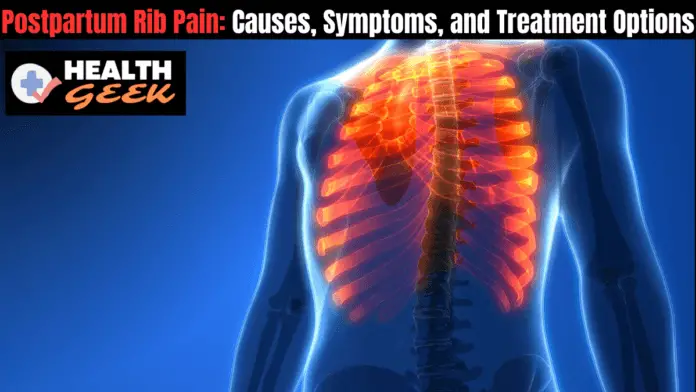
Are you experiencing rib pain after pregnancy? You’re not alone. Rib pain during and after pregnancy is a common issue that many women face. It can make it difficult to perform daily activities and take care of your newborn.
In this article, we will discuss the causes, symptoms, and treatment options for postpartum rib pain. We’ll also explore why left side rib pain postpartum is more common than right side rib pain and what you can do to alleviate your discomfort.
What Causes Postpartum Rib Pain?
Several factors can contribute to rib pain after pregnancy. Understanding the underlying cause of the pain is essential in determining the appropriate treatment. Here are some of the most common causes of postpartum rib pain:
Rib Flare
Rib flare is a common postpartum condition that causes the ribs to expand and widen to make room for the growing fetus. After delivery, the ribs might not return to their pre-pregnancy position, resulting in a flared rib cage. This condition can cause discomfort and pain in the rib area.
Hormonal Changes
Hormonal changes that occur during pregnancy can also cause postpartum rib pain. Hormones, such as progesterone, can cause the ligaments and joints in the body to relax and loosen. This loosening of the rib cage can cause strain and pain.
Muscle Strain
The abdominal muscles can also contribute to pain in the rib cage. The muscles in the abdomen work together with the muscles in the chest to support breathing and other functions. The strain caused by these muscles during pregnancy and delivery can lead to postpartum rib pain.
Breastfeeding
Breastfeeding can also be a contributing factor to postpartum rib pain. The constant pressure of holding the baby in the same position for extended periods can cause strain on the rib cage.
Read: How to Get Rid of a Cold While Breastfeeding
Symptoms of Postpartum Rib Pain
Postpartum rib pain can present with several different symptoms, including:
- Pain or discomfort in the upper part of your torso, specifically your rib cage.
- Aches and pains that radiate into your back or neck.
- Difficulty breathing deeply.
- Tightness or pressure in your chest.
- Swelling or redness near your ribs.
If you experience severe or persistent rib pain, it’s important to seek medical attention immediately, as it may be a sign of a medical emergency.
Left Side Rib Pain Postpartum
Many women experience left side rib pain postpartum more frequently than right side rib pain. This is because your liver is located on your right side, and it’s less likely to be affected by postpartum changes in your body.
If you’re experiencing left side rib pain postpartum, there are several things you can do to alleviate your discomfort. These include:
- Applying heat or ice to the affected area.
- Resting as much as possible.
- Taking over-the-counter pain relievers such as acetaminophen or ibuprofen.
- Doing gentle stretching exercises or practicing yoga.
- Wearing loose-fitting clothing that doesn’t put pressure on your rib cage.
Read: Hip Pain after C-Section: Causes, Symptoms, and Treatment Options
Treatments for Postpartum Rib Pain
The treatment for postpartum rib pain will depend on the underlying cause of the condition. Here are some of the most effective treatments for postpartum rib pain:
Physical Therapy
Working with a physical therapist can help alleviate postpartum rib pain. The therapist can help identify any alignment issues that might contribute to the pain and recommend exercises to alleviate the discomfort.
Pain Medication
Over-the-counter pain medications can help alleviate the pain associated with postpartum rib pain. Ensure that you take the medication as directed by your healthcare provider.
Proper Rest and Positioning
Proper rest and positioning can help alleviate the discomfort associated with postpartum rib pain. Avoid activities that exacerbate the pain and try to find a comfortable position that will not put pressure on the rib area.
Breastfeeding Positioning
If breastfeeding is causing postpartum rib pain, changing the position in which you hold the baby can alleviate the discomfort. Experiment with different breastfeeding positions until you find one that is most comfortable.
Chiropractic Care
Chiropractic care can help address any misalignments or joint issues that contribute to the pain associated with postpartum rib pain. Working with a chiropractor can help alleviate the discomfort and help prevent future episodes.
When Should You See a Healthcare Provider?
If you’re experiencing persistent or severe rib pain after giving birth, make an appointment with your healthcare provider. They may perform a physical exam and order diagnostic tests like an X-ray or CT scan to determine the underlying cause of your pain.
Final Thoughts
Postpartum rib pain is a common issue that many new mothers face, but there are several treatment options available to help alleviate your discomfort. If you’re experiencing severe or persistent rib pain, it’s important to seek medical attention immediately, as it may be a sign of a medical emergency.
Remember to take care of yourself during this time, rest as much as possible, and seek treatment if necessary. With the right care and support, you can manage your postpartum rib pain and enjoy this special time with your newborn.











